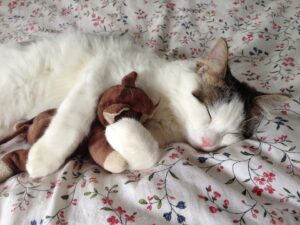-
Adopt
-
Veterinary Care
Services
Client Information
- What to Expect – Angell Boston
- Client Rights and Responsibilities
- Payments / Financial Assistance
- Pharmacy
- Client Policies
- Our Doctors
- Grief Support / Counseling
- Directions and Parking
- Helpful “How-to” Pet Care
Online Payments
Referrals
- Referral Forms/Contact
- Direct Connect
- Referring Veterinarian Portal
- Clinical Articles
- Partners in Care Newsletter
CE, Internships & Alumni Info
CE Seminar Schedule
Emergency: Boston
Emergency: Waltham
Poison Control Hotline
-
Programs & Resources
- Careers
-
Donate Now
 By Lisa Maciorakowski, DVM
By Lisa Maciorakowski, DVM
angell.org/generalmedicine
generalmedicine@angell.org
617-522-7282
In order to create the most “cat friendly” home it is important to understand and recognize the natural behaviors and instincts of our feline friends. Cats most enjoy their environment and their owner’s company when they are given a sense of control over situations and receive their basic needs in a non-stressful way. It is important to maintain an environment that allows the cat to use their natural instinctive behaviors.
 Cats are hunters and view their toys as “prey.” When they are playing and pouncing on their toys remember that they are hunting. They like toys that make noise or movement, including catnip can often increase the fun. Prey preference varies from cat to cat. To see what they like you should provide them with different types of toys. Furry toys on the ground (like mice) or feathers/objects in the air (birds), or tiny objects with lots of movement like a laser pointer (bugs). Some cats prefer to chase the toy and others prefer you to bring it towards them. Some like both, so try a variety. Cats often like toys that they can catch and fling into the air and catch again. To keep things interesting, rotate the toys unless there is an obvious favorite toy that they like to sleep with. Provide creative toys as long as they are safe – so that they aren’t able to bite off pieces that could be swallowed. Although nothing replaces “paws-on” toys, some cats also do enjoy the visual stimulation provided by nature videos with live critters. While toys/videos are great entertainment when cats are home alone, it is also important to ensure that they have plenty of interactive play time with their owners.
Cats are hunters and view their toys as “prey.” When they are playing and pouncing on their toys remember that they are hunting. They like toys that make noise or movement, including catnip can often increase the fun. Prey preference varies from cat to cat. To see what they like you should provide them with different types of toys. Furry toys on the ground (like mice) or feathers/objects in the air (birds), or tiny objects with lots of movement like a laser pointer (bugs). Some cats prefer to chase the toy and others prefer you to bring it towards them. Some like both, so try a variety. Cats often like toys that they can catch and fling into the air and catch again. To keep things interesting, rotate the toys unless there is an obvious favorite toy that they like to sleep with. Provide creative toys as long as they are safe – so that they aren’t able to bite off pieces that could be swallowed. Although nothing replaces “paws-on” toys, some cats also do enjoy the visual stimulation provided by nature videos with live critters. While toys/videos are great entertainment when cats are home alone, it is also important to ensure that they have plenty of interactive play time with their owners.
It is also a natural instinct for cats to scratch – it stretches their muscles, sheds/sharpens their claws, and leaves a scent by which they can mark their territory. For these reasons it’s very important to provide plenty of acceptable scratching outlets. Some cats prefer to scratch upwards and some along the ground, and so make sure to provide both horizontal and vertical scratching posts to find out which your cat prefers. Make sure that the posts are tall/long enough to extend along their entire reach and sturdy enough so that it doesn’t topple over. In order to find out their preferred surface/position offer them different options. To decrease the chance of furniture destruction you should provide scratching outlets in various areas of the home. Since they often like to stretch after a nap and to mark territory, posts should be provided near their sleeping area, at room entrances and in public places.
If you catch them using an undesirable scratching spot, like a piece of furniture, quickly distract them with noise or fast motion. However, be careful not to shout or swat as the cat may perceive it as life-threatening. Instead provide a surface they like to scratch most and put it near the furniture they were using. In addition, you should cover the furniture or spray it with a non-irritating cat repellent (e.g., citrus spay). Make sure to praise them when they are scratching on a desirable surface.
Good resting areas are important for supporting a cat’s hiding instinct. Cats like to rest in areas that they feel to be safe, quiet, secure and comfortable. They should be given the option to escape from the family. Some cats prefer elevated beds/hiding spots, especially if kids or dogs are present. Their refuge should be a comfortable temperature and an out-of-the-way area with access to food, water, litter box, scratching post, perch, window and toys. Some like covered beds while others prefer slings…or anything cozy! If there is more activity going on in the house than usual, the cat’s resting area can be sprayed with Feliway (a natural relaxing pheromone) and music turned on to muffle the other loud sounds and help to make their area feel safer and more inviting. Some cats are sensitive to something as small as moving furniture or having company over. Also, make sure to respect your cat’s privacy – don’t bother them when they are sleeping or hiding. Cats prefer to come to us on their own terms and prefer shorter but frequent visits. It’s important to understand that cats naturally like to rest between “hunts” so sleep/wake cycles occur often throughout the days and nights. If your cat is particularly active at night, you can add playful activities during the day to help them sleep more at night time.
Perches are essential not only for escape but also for “viewing” purposes. Make sure to provide some places for them to climb that will provide them with a view around and out of the house. Outside of their window you can place a bird feeder and flowers to attract birds, bees and other bugs for them to watch.
In order to keep cats content with their “bathroom” situation, the number of litter boxes provided should be one more than the number of cats in the home. Most cats prefer uncovered boxes filled with at least 2 inches deep of fine grain, unscented litter. The boxes should be big enough for the cat to stand up and comfortably turn around inside. Ideally all boxes would be in a separate area and one on each floor of the home. As cats like to mark “new” territory with their urine make sure the litter boxes stay very clean. The litter boxes should be scooped daily and washed weekly. Make sure they are placed in a location away from things that can possibly scare the cat (like appliances and air ducts that can unexpectedly turn on).
Cat food, like the litter boxes, should be provided in an area away from people/things that could suddenly startle the cat. Since cats are solitary hunters of small prey and enjoy catching their own meal, hiding their treats or kibble around the house can be a great way for them to find/hunt for their food. You can also purchase balls with holes that can be filled with food so that the cat has to be active and stimulated to get the pieces of kibble for them to eat it.
We can use our understanding of cat behavior to improve the environment of the indoor cats that share our lives. When we provide acceptable outlets for cats to “do what they need to do” and protect them from perceived threats, we reduce the sources of stress that can negatively affect their health and behavior. It’s important to minimize even small life stressors and changes in the environment that may affect their well-being. Remember to give them choices for everything so that they can maintain a sense of control. Be creative in designing their rest areas and in providing toys….think like a cat! And most important of all, reassure them with daily playing, petting, grooming and love.